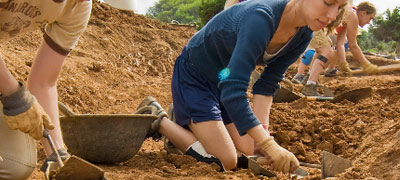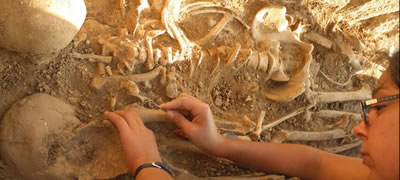006. Dig in the Roman City of Sanisera.

The research is focused on the archaeological excavation of Sanisera and it studies what happened in this Roman port connected to the maritime traffic that sailed the Mediterranean during those times. As a result, we know that this is a very interesting archaeological site, with abundant findings of multiple artifacts that will help us to reconstruct its past.
The excavation at the Roman city of Sanisera provides all the archaeological documentation necessary for the student to acquire enough training and experience in all aspects involving an excavation of the Roman civilization from the II century B.C. to the VI A.D.
![]() General Information What you will learn Useful Information Staff Session & Cost
General Information What you will learn Useful Information Staff Session & Cost
008. Digging Anthropology in the Sanisera Necropolis

Fieldwork focuses on the excavation of funerary structures, specifically inhumation graves. In the laboratory students will learn to classify artifacts found, mainly human skeletal remains.
![]() General Informaton What you will learn Useful Information Staff Sessions & Cost
General Informaton What you will learn Useful Information Staff Sessions & Cost
010: Digging remains and Biological Anthropology in Sanisera
 This course focuses on the excavation and study of both the urban structures of the Roman city of Sanisera, where a monastery has been found and the excavation of inhumation tombs from the classical period. In the laboratory students will learn to classify artifacts found, including Roman pottery, numismatics and faunal remains.
This course focuses on the excavation and study of both the urban structures of the Roman city of Sanisera, where a monastery has been found and the excavation of inhumation tombs from the classical period. In the laboratory students will learn to classify artifacts found, including Roman pottery, numismatics and faunal remains.
![]() General Information What you will learn Useful Information Staff Sessions & Cost
General Information What you will learn Useful Information Staff Sessions & Cost
018 Advanced Osteological Analysis in the Roman Necropolis of Sanisera
 This course focuses on the in-depth analysis of human skeletal remains excavated from the Roman necropolis of Sanisera. In this course we will use advanced osteological techniques to gain a better understanding of the lifestyle of population of Sanisera.
This course focuses on the in-depth analysis of human skeletal remains excavated from the Roman necropolis of Sanisera. In this course we will use advanced osteological techniques to gain a better understanding of the lifestyle of population of Sanisera.
![]() General Information What you will learn Useful Information Staff Session & Cost
General Information What you will learn Useful Information Staff Session & Cost
050 GIS, AutoCAD & Digital Illustration in archaeology
 This course is designed for students that have participated in an archaeological excavation and would like to learn about archaeological tools used to document research information collected with rigor and quality, thanks to the handling of the field data processing translated to AutoCAD or/and ArcGIS software to create stratigraphic maps of the excavation.
This course is designed for students that have participated in an archaeological excavation and would like to learn about archaeological tools used to document research information collected with rigor and quality, thanks to the handling of the field data processing translated to AutoCAD or/and ArcGIS software to create stratigraphic maps of the excavation.
If you are interested in archaeology as well as how to process this information using technical drawing, and digital illustration then this is the course you are looking for. This course accommodates participants with or without previous experience.
![]() General Information What you will learn Useful Information Staff Session & Cost
General Information What you will learn Useful Information Staff Session & Cost
053 Bioarchaeological fieldwork of an underground funerary crypt of the San Mateo Church
 The San Mateo Church is one of the churches with the greatest architectural and artistic interest in the city of Jerez (Cádiz, Spain), founded during the medieval period, most of its building presents the typical Gothic architecture of the 14th - 15th centuries, with additions from the Renaissance and Baroque art.
The San Mateo Church is one of the churches with the greatest architectural and artistic interest in the city of Jerez (Cádiz, Spain), founded during the medieval period, most of its building presents the typical Gothic architecture of the 14th - 15th centuries, with additions from the Renaissance and Baroque art.
The objective in this course of bioarcheological fieldwork will be to excavate the burial niches dating from the seventeenth century of the underground funerary crypt that belongs to the San Mateo Church. An old plan of the church basement confirms that the church basement houses a large number of burial tombs. This will be the first time this funerary crypt has been excavated.
![]() General Information What you will learn Useful Information Staff Session & Cost
General Information What you will learn Useful Information Staff Session & Cost






